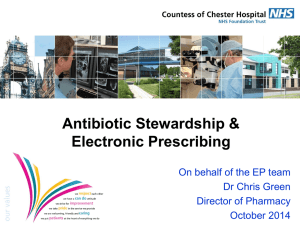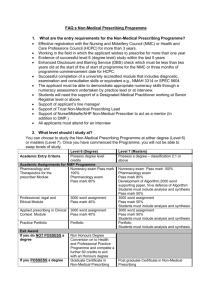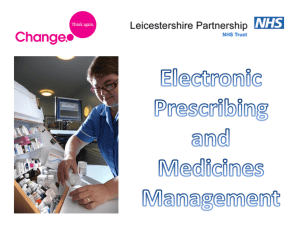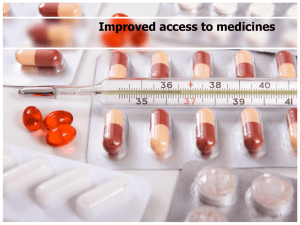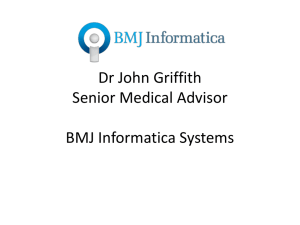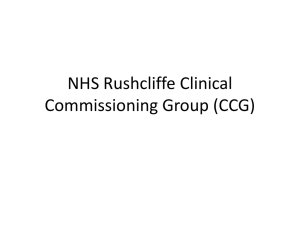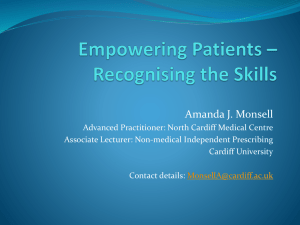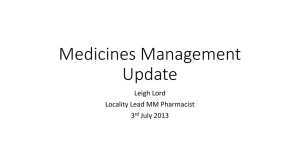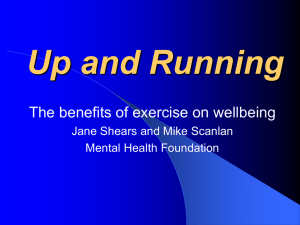Non-Medical Prescribing - Workforce Modernisation Hub
advertisement
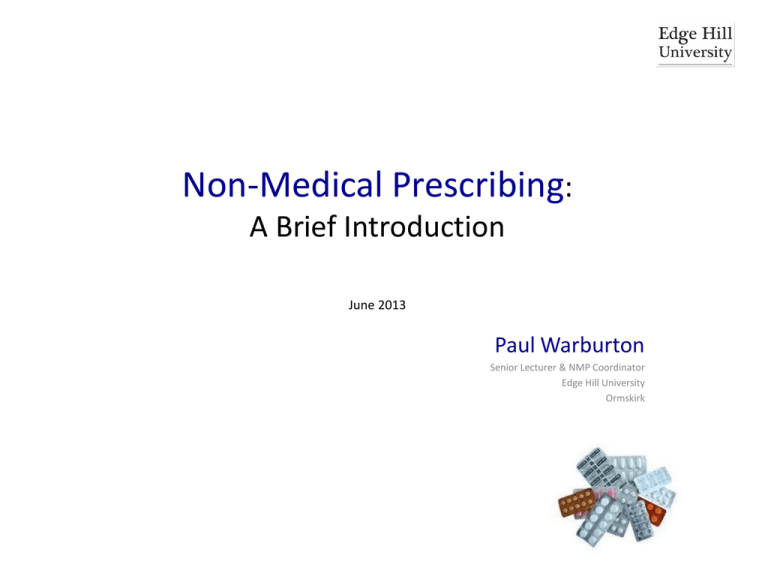
Non-Medical Prescribing: A Brief Introduction June 2013 Paul Warburton Senior Lecturer & NMP Coordinator Edge Hill University Ormskirk Non-Medical Prescribing The purpose of NMP Who is eligible Numbers Benefits Examples Opportunities for commissioners & the NHS Q’s Medicines Act 1968 • Controls the production and supply of medicinal products • Main purpose is to protect the public from harm i.e. to ensure as far as possible that medicinal products are safe and efficacious • Identified practitioners that have the authority to prescribe – at that time Doctor, Dentist, Vet; amended to enable NMPs to prescribe • Categorises medicinal products General sales list Pharmacy medicines Prescription only medicines GSL P POM Eligible Non-Medical Prescribing Professions Experienced*; Nurses, Pharmacists and Allied Health Professionals (Physio’, Radiographers, podiatrists and optometrists) are eligible to enter a programme of study. Programme consists of 26 days learning plus 12 days in practice. Universities approved by Professional Regulators to prepare Nurses (Nursing and Midwifery Council (NMC)), Pharmacists (General Pharmaceutical Council (GPhC)) and Allied Health Professionals (Health and Care Professions Council (HCPC)) Successful completion enables recording of qualification with professional regulator •Pharmacists a minimum of 2 years post registration experience, Nurses & AHPs a minimum of 3 years The year preceding the course working in the areas they intend to prescribe Assessment Strategy 1hr examination – multiple choice and short answer question- based upon drug actions, interactions and applied information and data. Pass mark 80% 30 min examination - 4 Drug Calculations Pass mark 100% 15 min Objective Structured Clinical Examination - including writing a Prescription Pass Mark 80% 3000 word prescribing case study Pass mark 40% A reflective Portfolio Pass/ Fail Practice based assessment – (Competencies) Pass/ Fail Students must successfully pass all components in order to achieve the 45 credits at Level 6 and the recordable qualification. The Aims of Non-Medical Prescribing To: • • • • Make more effective use of the skills and expertise of groups of professions Improve patients’ access to treatment and advice Improve patient choice and convenience Contribute to more flexible team working across the NHS ”Extending Prescribing responsibilities is an important part of our commitment to modernise the NHS. By expanding traditional prescribing roles, patients can more easily access the medicines they need from an increased number of highly trained professionals” Patricia Hewitt Secretary of State for Health, November 2005 Change: The only constant in the NHS Drivers of Change Numbers of registered NMPs – April 2012* April 12 Numbers of registered non-medical prescribers Community Practitioner Nurse Prescribers 25,958 Nurse Independent/Supplementary Prescribers 20,615 Pharmacist Independent/Supplementary Prescribers 1,598 Pharmacist Supplementary Prescribers 333 Optometrist Independent Prescribers 119 Physiotherapist Supplementary Prescribers 222 Podiatrist Supplementary Prescribers 152 Radiographer Supplementary Prescribers 31 Total 49,028 Source: Department of Health, 2012 Number of items prescribed by non-medical prescribers in primary care in England In England, 2011 > 1.3 million items prescribed on FP10 per month Source: NHS Information Centre, 2012* Number of items prescribed by NMP type Jan - Mar 12 Oct - Dec 11 July - Sept 11 Apr - Jun 11 Jan - Mar 11 Oct - Dec 10 July - Sept 10 Apr - Jun 10 Jan - Mar 10 Oct - Dec 09 July - Sept 09 Apr - June 09 Jan - Mar 09 Oct - Dec 08 July - Sept 08 Apr - June 08 0 500,000 1,000,000 1,500,000 2,000,000 2,500,000 3,000,000 3,500,000 4,000,000 4,500,000 5,000,000 Number of items prescribed Community Practitioner Nurse Prescriber Nurse Independent Prescriber Pharmacists Physiotherapists Chiropodists/ Podiatrists Practice unidentified supplementary PCT unidentified supplementary Source: NHS Information Centre, 2012* Non-medical prescribing by therapeutic area (2005-11) 2500000 2000000 1500000 1000000 500000 0 2005 / 2006 2006 / 2007 Appliances Central Nervous System Endocrine System Infections Respiratory System Others Source: NHSBSA, 2012 2007 / 2008 2008 / 2009 2009 / 2010 2010 / 2011 Cardiovascular System Dressings Gastro-Intestinal System Obstetrics,Gynae+Urinary Tract Disorders Skin Methods of Prescribing Independent prescribing – Nurses (V300), Pharmacists Prescribing by a practitioner, who is responsible and accountable for the assessment of patients with undiagnosed or diagnosed conditions and for decisions about the clinical management required, including prescribing. (DH 2006) Supplementary Prescribing – AHPs, Nurses (V300), Pharmacists A voluntary partnership between an independent prescriber* and a supplementary prescriber, to implement an agreed patient-specific Clinical Management Plan with the patient’s agreement *For the purposes of supplementary prescribing, the independent prescriber is a doctor Limits on Independent Prescribing? Patient safety remains paramount • Role and scope of prescribing agreed by employer • Limits on prescribing role: Legislation eg. CFNP very limited formulary, Competence Individual Formulary/ Trust Formulary Trust Policy • Even though they have the legal right to do so, no NMP will prescribe from the whole of the BNF; Individual professionals will only prescribe from a limited range of medicines within their formulary, competence and area of clinical expertise • Prescribers are accountable for their actions! Examples of service delivery and redesign • Allied Health Professional led services: – Intensive care outreach, musculoskeletal review clinic, community children’s outreach, podiatry services, consultant physiotherapist pain clinic, respiratory care…… • Pharmacist led Services: – Care home medication review, medication review, mental health services, community cardiovascular clinics, smoking cessation, post traumatic stress services, ward prescribing, discharge …. • Nurse led: – Diabetes, heart failure, rheumatology, Hepatitis, drugs & alcohol, acute & community mental health crisis, TB, scope clinics, walk-in centres, community matrons, ITU outreach, community children’s services, tissue viability, DVT services, intermediate care, palliative care, homeless outreach, acute pain services, parkinson’s disease, night nurse practitioner ……. QIPP Quality Improvement Productivity Prevention NMP enables many positive outcomes; – Adherence to medications – Service redesign – Waste reduction • NMPs able to complete episodes of care • Reduced need for medic – Improved outcomes • Timely, appropriate intervention – Patient satisfaction • Improved access to appropriate healthcare - Cost effective – Effective use of a highly skilled workforce • Improved staff satisfaction – Improved quality of care NHS NW NMP Clinicians Audit 2012: > 19,000 Clinical interventions logged Prevention of… events; Health organisations are continuously looking to improve the experience and quality of services offered through innovative approaches. Non-Medical Prescribing enables organisations to deliver these approaches in addition to required productivity gains and wider public health agenda. http://www.prescribingforsuccess.co.uk/document_uploads/nmp-staff-stories/NMP_NHS_Staff_Stories.pdf ?! Summary NMP: An essential skill of the nurse, pharmacist and AHP of the future Non-Medical Prescribers: Experienced, well qualified, senior, autonomous….. • Enable the completion of episodes of care by appropriate clinicians • Improve access to appropriate medications • Promote adherence to medications and patient safety • Enable service redesign and improvement • Promote efficient, effective and cost-effective health care • Enhance patient care and outcomes ‘excellence will save you money and excellence can always be found in the most highly developed workforce.’ Non-medical prescribers can deliver excellence. (Lilley 2012) Questions? "If I know the answer I'll tell you the answer, and if I don't, I'll just respond, cleverly.” Rumsfeld D (2006) Paul Warburton Senior Lecturer & NMP Coordinator Edge Hill University Ormskirk warburtp@edgehill.ac.uk 01695 657060 • But think about this. Only nurses can do what only nurses can do. They can also do what an HCA can do. And, they can also do a lot of what doctors do. Asthmatics, diabetics, warfarin users, endoscopy-seekers and minor surgery-needers, intensive care customers and theatre goers can all be looked after by nurses, prescribed for by nurses, washed by nurses and fed by nurses. End-2-End Care. • Nurses have reinvented primary care and made GPs rich by harvesting most of the QoF points for them. The scope of nursing influence on modern healthcare, in hospital and outside and on family life has ballooned, blossomed and grown beyond recognition. It is a boardroom truth; excellence will save you money and excellence can always be found in the most highly developed workforce. Nurses can deliver excellence. NPC May 2012
